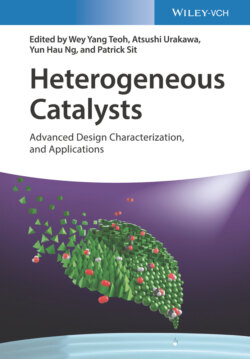Читать книгу Heterogeneous Catalysts - Группа авторов - Страница 74
6.2 Concept and Advantages of SACs 6.2.1 Concept of SACs
ОглавлениеThomas defined a new class of catalysts as uniform heterogeneous catalysts in 1988 [19]. His group synthesized a Ti‐based single‐site heterogeneous catalyst (SSHC) by grafting metallocene complexes onto mesoporous silica [20]. Heiz and coworkers loaded size‐selected Pdn clusters on MgO(100) films by mass‐selected soft‐landing techniques [21]. Interestingly, they found that a single Pd atom is enough for the production of benzene from acetylene cyclotrimerization. Thomas et al. renamed this class of catalysts as SSHCs [22]. Thomas also categorized SSHCs into four subclasses, one of which includes individual isolated atoms anchored to supports. Böhme and Schwarz proposed the concept of single‐site catalysis in gas‐phase experiments [23]. Qiao et al. observed single Pt atoms anchored on FeOx surfaces by using high‐resolution high‐angle annular dark‐field‐scanning transmission electron microscopy (HAADF‐STEM), and they coined a new concept of single‐atom catalysis in 2011 [16], thus provoking a hot debate on whether SAs alone can act as active sites in heterogeneous catalysis. Yang et al. generalized the concept and examples of “single‐atom catalysts” in 2013 [17]. Since then, the research on SACs has progressed rapidly. SACs have attracted much attention due to the following aspects.
